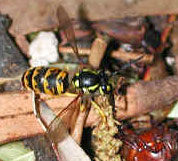Wasps

Wasps are a diverse group of insects. In Australia alone there are over 12,000 species, ranging from the tiny diapriid wasps, which are barely visible to the naked eye, to the spider and cicada-killer wasps, capable of taking large prey. Most wasps have carnivorous larvae that feed on other insects and spiders. The adults provide food for them by capturing prey or by laying the egg on or near the food source, which might be an egg, larva or pupa of another insect.
-
Features of wasps:
- The egg-laying structures (ovipositors) in some wasps are modified into stingers.
- Adults generally feed on nectar and can pollinate flowers in the process.
- Some are hyper-parasites, which use other parasitic wasps' larvae or hosts to feed their young.
- Many wasps can act as biological control agents on crop pests.
- Most native species are solitary, but a few, such as the paper wasps, form colonies.
European Wasps
The European Wasp is an introduced species that was first detected in Australia in 1959. Since then it has spread to many parts of the country including Melbourne. The wasp enjoys the warmer Australian conditions and nests can grow to three metres in length and contain hundreds of thousands of wasps.
Because they are attracted to cool drink and meat they are a particular hazard around barbecues and also for pets. If swallowed they can sting repeatedly (unlike a bee that can only sting once) and cause asphyxiation through swelling.
Physical Features
The European Wasp is about the same size and shape as a honey bee but is not hairy. It has distinct bright yellow and black triangle-shaped markings on the body. It is not to be confused with the Papernest wasp that is more slender and has an obvious waste section. The European Wasp has black, long antennae, the wings are folded at rest and when they fly they hold their legs close to their body.
The Nest
The European Wasp’s nest is always concealed. It is usually underground but can be located inside a hollow tree, a space in a retaining wall or embankment, in a wall cavity or the ceiling space of a house. The nest varies in shape depending on its location but can be very large. It consists of layers of cells and the outside is covered with flaky pieces of chewed up and cemented wood fibre.
The Papernest wasp’s nest, in contrast, is usually small (about the diameter of a 50c coin), fully or partially exposed, honeycombed in appearance and is often found on the underside of eaves or hanging off a branch.
-
Precautions against the European Wasp
- Don’t leave food, drink or pet food outside.
- Collect fallen fruit.
- Ensure that your outdoor rubbish bins have tight-fitting lids.
- Cover compost bins.
- Cover food during a barbecue or picnic.
- Don’t drink straight from a can or bottle when outside, drink from a straw.
- If you see a European Wasp leave it alone – it will only attack if provoked.
Do not attempt to remove the nest yourself as this can be extremely dangerous. Call Melbourne Pest Control to have an experienced pest controller take care of your problem.

